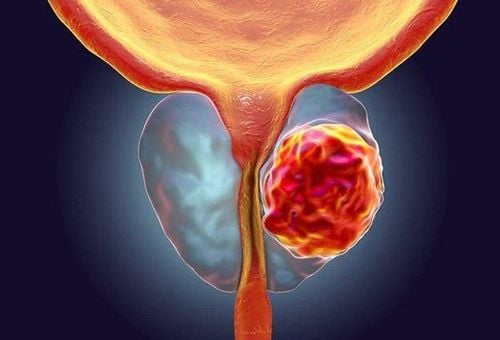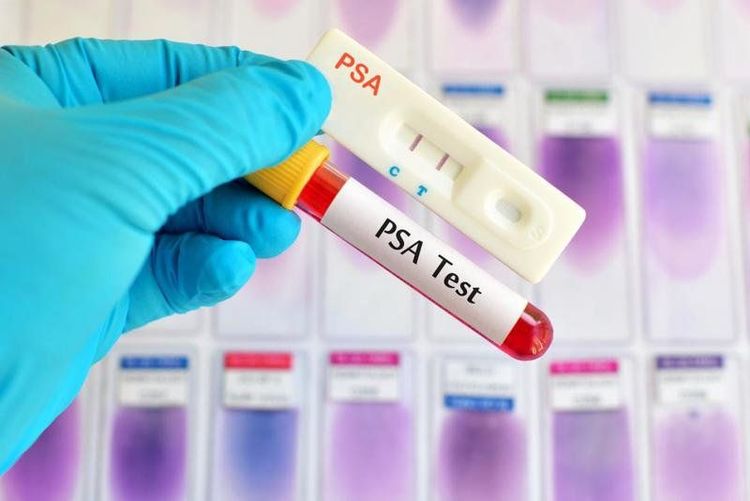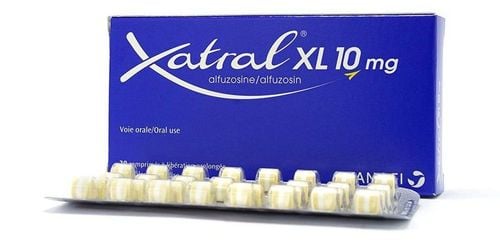This is an automatically translated article.
Prostate cancer is a preventable disease if diagnosed early and treated promptly. For patients with localized cancer, small tumor size, active surveillance is considered optimal to maintain a normal life and reduce the risk of disease progression.1. What is prostate cancer?
In recent years, the number of prostate cancer cases has increased. The estimated prevalence in men is 1:8. However, this is a preventable disease through early diagnosis and treatment.The most common method of diagnosing prostate cancer is a blood test. This is a diagnostic procedure for asymptomatic patients. The test results will tell us the amount of prostate-specific antigen (PSA), a protein secreted by the prostate gland into the bloodstream, the higher the amount of PSA, the greater the risk. When the PSA level in the blood is greater than 10 ng/mL, there is a 50% risk of prostate cancer.
However, to confirm a patient has prostate cancer or not, the doctor will conduct additional testing methods such as prostate biopsy, transrectal ultrasound, etc..
Article Treatment of prostate cancer depends on the extent of the disease of each patient, with two steps of active monitoring and surgery/chemotherapy/radiotherapy. With active follow-up, patients with prostate cancer face fewer risks and can live a normal life for many years before proceeding to other treatment steps. However, this method only applies to patients with small and localized cancers. When the disease has reached the stage that requires treatment, surgery is often the most effective method of treatment.
Surgery or surgery combined with radiation therapy or hormone therapy is the most basic treatment for prostate cancer because it offers the highest long-term survival rates.

Phương pháp chẩn đoán ung thư tiền liệt tuyến phổ biến nhất đó là xét nghiệm máu
2. The role of active surveillance in prostate cancer monitoring and treatment
Active surveillance for prostate cancer is a method that can help doctors keep a close eye on the cancer and to recognize any changes to a patient's body.No cancer treatments are performed during active surveillance for prostate cancer. This means that drugs, radiation, and surgery are not used. Signs of growing cancer are managed by routine tests.
This method is especially effective for patients with small, very slow-growing prostate cancer that is limited to one area of the prostate gland and causes no signs or symptoms. If the patient has other health problems that can shorten life expectancy, aggressive surveillance for prostate cancer may also be a reasonable and effective approach.
3. For whom is active surveillance for prostate cancer appropriate?
Active surveillance for prostate cancer is used to prevent treatment side effects in male patients at low risk of prostate cancer progression.Prostate cancer is a very slow growing disease and if the cancer is very small it may not have any signs and symptoms. As a result, many patients can still lead completely normal lives before the cancer grows large and requires treatment.
Active monitoring of prostate cancer may be appropriate in the following situations:
When the patient has a small tumor size. If the cancer is found early, when it is still small and confined to one area of the prostate gland, active surveillance may be a reasonable option. When the patient has a low Gleason score. Active surveillance may be most appropriate for male patients with low Gleason scores, usually 6 or less. When the patient has other serious health problems. Active follow-up is an effective solution for patients with other health problems that can shorten life expectancy or for patients whose health prognosis will be impaired if treated for prostate cancer. paralysis.

Theo dõi tích cực ung thư tuyến tiền liệt có thể phù hợp khi bệnh nhân có kích thước của khối ung thư nhỏ
4. Prostate Cancer Active Monitoring
During active follow-up, the patient will see a doctor regularly to monitor the progress of the cancer at a frequency of every few months. During these visits, the doctor may perform the following tests and procedures:Digital rectal exam: During a digital rectal exam, the doctor examines the prostate gland gently Gently insert a gloved finger into the rectum so that the surface of the prostate can be felt and assessed to see if cancer has grown.
PSA blood test : The PSA test measures the amount of prostate-specific antigen (PSA) in a patient's blood. If the PSA is increased it can indicate the growth of cancer. Ultrasound or magnetic resonance imaging (MRI): If other tests raise concerns, your doctor may use transrectal ultrasound or MRI to further evaluate the prostate. Prostate cell collection (prostate biopsy): Collection of a sample of cells from within the prostate is usually recommended one year after the initiation of active monitoring to determine the extent of prostate growth. cancer and reassess the Gleason score to see if the cancer continues to grow slowly.

Xét nghiệm PSA đo lượng kháng nguyên đặc hiệu tuyến tiền liệt (PSA) trong máu của bệnh nhân
5. Possible risks during active surveillance for prostate cancer
The risks of active surveillance for prostate cancer that patients may experience include:Feelings of anxiety. You may feel anxious and uncertain about your cancer status. Once the option of active follow-up is selected, it means that the patient must be ready to see a doctor every few months.
Risk of cancerous growth. Cancer can grow and spread during follow-up. If the cancer metastasizes, the patient may miss the opportunity for effective treatment.
Fewer treatment options. If the cancer has spread, the patient may have fewer treatment options.
A lot of men choose to actively monitor prostate cancer and never have prostate cancer treatment. Cancer may never develop and they can live a completely normal life like everyone else.
But some patients may consider prostate cancer treatment options if the cancer begins to grow faster than expected, the cancer has spread outside a limited area in the prostate, the cancer cancer causes signs and symptoms. Prostate cancer treatment options depend on the specific condition, but may include surgery, medications, and radiation.
Vinmec International General Hospital is one of the hospitals that not only ensures professional quality with a team of leading medical doctors, a system of modern equipment and technology. The hospital provides comprehensive, professional medical examination, consultation and treatment services, civilized, polite, safe and maximum sterilization space. Customers when choosing to perform tests here can be completely assured of the accuracy of test results.
Please dial HOTLINE for more information or register for an appointment HERE. Download MyVinmec app to make appointments faster and to manage your bookings easily.
Article referenced source: mayoclinic.org












